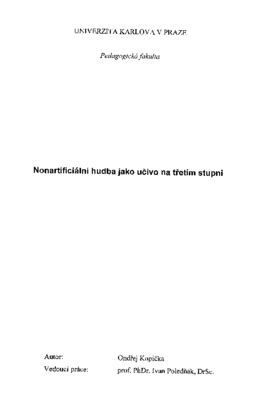Nonartificiální hudba jako učivo na třetím stupni
Non-artificial Music as Subject Matter for Secondary Schools
diploma thesis (DEFENDED)

View/
Permanent link
http://hdl.handle.net/20.500.11956/3961Identifiers
Study Information System: 20917
Collections
- Kvalifikační práce [19351]
Author
Advisor
Referee
Drábek, Václav
Faculty / Institute
Faculty of Education
Discipline
Training Teachers of General Subjects at Lower and Higher Secondary Schools Music - Choir Conducting
Department
Information is unavailable
Date of defense
24. 5. 2006
Publisher
Univerzita Karlova, Pedagogická fakultaLanguage
Czech
Grade
Very good
Prvním naším krokem bude snaha o zmapování dosavadního vývoje užití nonartificiální (NA) hudby ve školní výuce. Projdeme některé učebnice, které se u nás používaly za posledních padesát let a budeme si všímat integrace NA do výuky, zastavíme se rovněž u některých zajímavých pedagogických materiálů a diplomových prací, které se snaží o novou koncepci hudební výchovy, nebo se již podobným tématem v minulosti zabývaly. Nakonec shrneme a zhodnotíme současný stav hudební výchovy na třetím stupni. Powered by TCPDF (www.tcpdf.org)
This work examines the nature and significance of using popular music in music education. Through historical research and practical principles, it aims to construct a foundation for a new system of high school music education. The work unfolds in four parts. Part 1 probes past and present appearances of popular music in music education, especially in high-school textbooks. Part 2 is a contribution to the new system of education, based on an unbiased approach towards music. We are trying to understand the role of music in the lives of our students and give them appropriate examples to work with on the field of harmony, melody, rhythm and form analysis. However, this approach also deserves to illustrate the context of music in human life, where popular music quite often overwhelms all other styles. This part asks three major questions: Why to teach it, What to teach and How to teach it. Given answers should unravel the concept itself and illustrate the system as well as particular types of connection between music and other subjects (such as math, history, social studies etc.) Part 3 aims to serve as an illustration of a modern multimedia high-school textbook and proposes a new concept of music curriculum development for music teaching and learning. Finally, part 4 deals with attachments such as sounds,...
